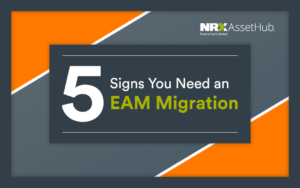Why do EAM migrations fail so often? There are countless reasons why a failure can occur, but more likely than not, the EAM just wasn’t set up for success. Conducting a successful EAM migration can become extremely difficult without extensive knowledge of the process and strong awareness of what works and what doesn’t. When project leaders can’t spot the potential causes of failure before the migration is attempted, things will quickly begin to fall apart. To help prevent this from happening, we’ve listed some common mistakes that are made throughout the EAM migration process that typically result in failure.
Fix These Mistakes!
Inappropriate Selection for Needs – Unfortunately, failure can occur right from when a company is selecting their new EAM. Whether it’s a lack of research or unclear specifications from a provider, some companies end up implementing an EAM that doesn’t suit their needs. When this happens, time, money, and resources will flow toward a goal that is unwanted. Make sure you’re adopting an EAM system that will help fulfil your company’s needs and goals from the start.
No Dedicated Team – The EAM migration process is a large undertaking, so assembling a dedicated team is crucial to the project’s success. Some companies assign the task to a mere one or two employees to get the job done, leaving their entire project in jeopardy. This is simply not enough resources to get the job done correctly in a time-efficient manner. Everything about your new EAM migration needs to be precise so that it’s effective from the time it becomes operational – without a dedicated team, many mistakes are bound to occur.
Insufficient Training – Sadly, just having a team isn’t enough; they need thorough training beforehand to successfully complete the migration process and utilize the system itself. Companies that skimp out on providing proper training for employees only hurt themselves as their primary users aren’t educated enough to use the new EAM properly. This scenario leads to an extreme loss of potential and general dysfunctionalities within company operations. Overall, it’s a sure way to cause an EAM migration failure.
Poorly Formatted Data – A company’s asset and maintenance master data is arguably the most important aspect of any EAM system. As such, this information needs to function well within your new system so it can perform optimally. Without cleansing and formatting your asset and maintenance data accordingly, operations will quickly become a downfall. Once your data fails to perform, the rest will follow. Ensure that these steps are taken before any data is transferred to your new EAM.
New System Not Tested – The new EAM needs to be tested after the migration is complete. There’s a lot happening throughout the EAM migration process, and consequently, there are many things that could make it function in ways that weren’t intended. Testing it before adopting it as your final product will prevent any serious malfunctions from occurring and keep downtime at a minimum. When left untested, serious damage to company operations can take place and the EAM will undoubtedly serve as testimony to these events.
We Set You up for Success
If you can manage to avoid these costly mistakes throughout your EAM migration process, you’re one step closer to a successful project. There are many more complicated aspects to the EAM migration process, and for those, we can help. NRX AssetHub provides the software and services you need to seamlessly transition into your new EAM of choice. If you want your next EAM migration project to be a success, make sure to reach out and book a demo with us.
Was Your EAM Migration Successful?
Planning an EAM Migration: Asking the Right Questions
5 Signs You Need an EAM Migration
Share this article




